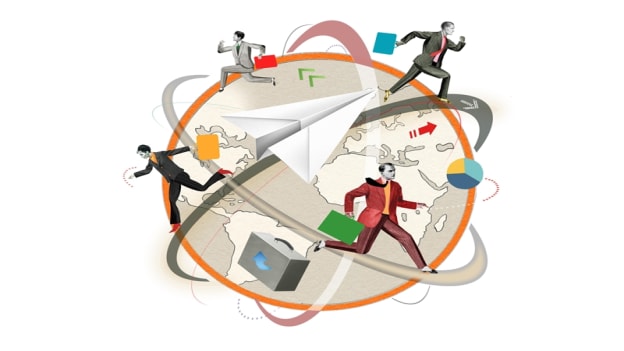How globalisation improves sustainability in organisations

The IMF describes globalization as “the growing economic interdependence of countries worldwide through the increasing volume and variety of cross-border transactions in goods and services and of international capital flows, and also through the more rapid and widespread diffusion of technology.” Globalisation can be through a process in which business decision, production processes, and markets gradually exhibit more ‘international’ characteristics and less ‘national’ ones. Globalisation implies a lot of structural reforms. (eg. Business organisation, the public-private interface, and altered consumption pattern). The Government can influence the pace and direction of globalisation. The tools that facilitated this growth were international transportation, technology, and telecommunications that became cheaper, quicker, and of higher quality and now the Internet. Globalization is also influenced by international organizations like the World Bank, the IMF, and the WTO, devoted to increasing trade and development. The result is multinational enterprises (MNEs) with budgets larger than the economies of many countries.
Whereas sustainable development for organizations means that the development that lasts. The key features that are required for sustainable development are:
- Make wider use of markets
- Strengthen decision-making processes
- Harness latest technology
- Manage links to global economy
To grow the sustainability of the business along with the implementation of organizational measures, the following elements must be ensured:
- Improving the quality of services and the relationships with suppliers;
- Improving the human resources management along with the requirements of organizational change;
- Implementing the organizational change process to increase the business sustainability will consider the diversification of activities and human resource training;
Companies need to rethink the structure of the modern corporation to determine what, specifically, has to be done in-house and what tasks should be outsourced to a global network of partners. Depending on the industry and products, this model might include U.S. chipmakers, Taiwanese engineers, Indian software developers and Chinese manufacturing sites. With domestic enterprises having to accept fierce competition from foreign competitors, creating a sustainable advantage has never been harder. Companies are at risk of losing customers who have more choices and are looking — and often finding — alternative providers they think can do better. Clearly, better service will ensure repeat business and strong customer loyalty as seen by the billions of dollars that are won or lost because of a company's ability to respond quickly to customer needs.
The sustainability of globalization may or may not be in the same direction for all nations. Some countries may experience an improved local environment as a result of the globalization process whereas others experience a deteriorating one. The same applies for social or economic effects of the globalization process. Furthermore, sustainable development in one domain ‘may not necessarily relate to a sustainable development in another domain and what is sustainable for a country may be not for the global environment. Of course, the globalization result that most would want is one in which globally the environment, societies and the economic system develops sustainably, and all local environments‘ improve as well as the welfare of all nations. However, globalization is unlikely to achieve of these objectives simultaneously.
Primary Dimensions of Organizational Sustainability
- Strategic Sustainability -- Ensures Realistic Vision and Goal
- Personnel Sustainability -- Ensures Personnel Can Effectively and Reliably Perform
- Product and Program Sustainability -- Ensures High-Quality Products, Services and Programs
- Financial Sustainability -- Conducts Financial Reserve and Contingency Planning
Catapulting from a Regional Focus to the Global Arena
In 1984, a small Chinese company named Legend built and marketed PCs for the Chinese market. By 1994, it had sold 1 million PCs to Chinese consumers and, with a 25% market share, became the dominant PC provider in China. In 2003, the company was renamed Lenovo, and in 2005 it catapulted onto the global stage when it purchased the legendary IBM PC business. Not long ago, the notion that IBM would exit the PC industry it helped create would have been absurd; even more incredible was that a relatively unknown Chinese company would someday acquire IBM's PC business and become an instant global competitor.
Boeing partnered with HCL Technologies to co-develop software to help design navigation systems, landing gear and cockpit controls.
GlaxoSmithKline and Eli Lilly are partnering with Asian biotech research companies to reduce the average half-billion dollar cost of introducing a new drug.
Nike has been able to evolve its global presence through the careful selection of international sponsorships such as its previous long-standing relationship with Manchester United. Although sponsorship spending can be fairly unpredictable -- demand costs tend to surge due to triggers like championships and tournaments -- these partnerships have certainly helped the brand capture the attention of a global audience.
Coca-Cola is a great example of a brand using international marketing efforts. Though a large corporation, Coca-Cola focuses on small community programs and invests a lot of time and money in small-scale charity efforts. For example, in Egypt, Coca-Cola has built 650 clean water installations in the rural village of Beni Suef and sponsors Ramadan meals for children across the Middle East.
H&M is on track to increase new store openings by 10-15% a year. One of the secrets fuelling its global expansion strategy is optimizing its online experience. With an online shop available in 21 markets, including the U.S., H&M is doing everything in its power to create an easy-to-navigate, mobile-friendly online shopping experience.
However, in recent years two opposing but equally restrictive tendencies have emerged in the understanding of the concept of sustainable development: for some, it has become the subject of an excessively economic bias, being often used as a justification for faster growth on the grounds that this will help to reduce poverty and achieve ecological sustainability, all the same serving the purpose of promoting the opening up of markets, financial deregulation, privatisation of natural resources and bio piracy. However, organizational sustainability -- or the surviving or even thriving of an organization -- depends on much more than effectively managing the organization's finances. The impact of globalization has yet to be fully realized, but one thing is clear: the business rules for engagement will never be the same. Companies can no longer do it alone and expect success. It requires collaboration. Teaming with the right partners is essential to increase speed, promote innovation and gain market share. But globalization has made it more difficult to anticipate demand. In fact, demand continues to be less predictable and much more perishable. Companies that respond with the greatest flexibility to customer demand will be the market leaders of tomorrow.











